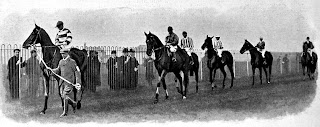From The Illustrated Sporting and Dramatic News Magazine dated November 24th 1900.
The Derby November Meeting
A highly successful meeting was concluded at Derby on Saturday, and a few of the most salient features are treated in our pictures. The attendance throughout was large, including a considerable number of aristocratic visitors closely allied with the world of sport. The Duke and Duchess of Devonshire entertained a party of friends at Chatsworth who were conveyed to and from the races by a private special train; whilst a similar method was adopted for the convenience of Lord Burton’s and Lord Carnarvon’s guests from Burton. Interest in the racing was well maintained from start to finish, much of it being of a high class. On Friday, the principal event on the card was the Derby Cup, which gave rise to a great deal of brisk speculation. After the market had settled down, Japonica was established a firm first favourite at 5 to 1, with Syeria, Santoi, and Innocence well backed by their connections. The race was run at a fairly good pace, and Japonica led into the straight, but soon after dropped out, thoroughly beaten. Syeria took up the running, when K. Cannon began to call upon Innocence with great determination, the result being that this horse drew away in the last fifty yards, and won by two lengths. Syeria ridden by J. Reiff, was second, and Refractor third. Aquascutum was placed fourth. It may be remembered that Innocence who has been a disappointment form some time past, was purchased from Mr J A Miller, on the disposal of that gentleman’s horses, by Mr C Morbey, for three thousand two hundred guineas, and it was though that full value had been paid for the son of Simonian and La verge. Mr Morbey is, however, a keen judge who thoroughly understands his business, and it is now obvious that when he bought Innocence he had none the worse of the bargain.
The last race on Friday was also interesting in view of recent Jockey Club proceedings, inasmuch as it was won by Lord Durham’s Gerolstein, ridden by F. Rickaby, odds of five to two were laid on Lord Durham’s representative, and a mile is probably his best distance, for he won in a canter by four lengths. Sport on the concluding day (Saturday) was remarkable for the large fields which contested almost every race. Of course, at this time of year, such keen competition is to be expected, and Derby invariably attracts an immense number of horses. The Chatsworth Plate, a five furlong handicap worth five hundred sovereigns, was won by Mr W Duke’s Inishfree, an American-bred three-year-old, who is clearly much better than he has been considered by the racing authorities; in fact, all his outings in this country have been successful. He beat a large field on Saturday in handsome style, and was well ridden by the American jockey, Rigby, so that it was a sort of triumph for Yankee combination. Mr T Cannon’s Marshcress, by Watercress-Celia III, a filly who, like Inishfree was bred in the United States, was made favourite for the Rangemore Stakes for two-year-olds, and never being headed, she won by a couple of lengths. Her performance created a favourable impression; she looks like growing in to a really good one. The Osmaston Nursery Plate of five hundred sovereigns was won by Laffan, a 100 to 8 chance, trained by W. E. Elsey, than whom not one of his confreres turns out, winners more consistently. Yet he has not always very high-class material to work on; he succeeds by merit, which ought to afford him great satisfaction, if not a pleasant surprise. Sinopi ridden by Maher-one of the most popular and skilful of the American jockeys- won the Allestree Plate, although he was not so fancied as Pan II and Succoth; whilst Old Clo’ ridden by Lester Reiff, won the concluding race of the meeting (a Queens Plate of two hundred sovereigns) easily by eight lengths, thus placing Reiff two points ahead of S. Loates the list of winning jockeys.
There is, generally speaking, no more popular and fashionable race meeting in the Midlands than that held at Derby, which seems to become more successful each year. The executive conducts its business with enterprise and energy; prizes are given that are worth winning, and consequently they attract a number of good horses to the post; and the arrangements are of an admirable and up-to-date character. The result is that this is a meeting which sportsmen invariably attend with pleasure, since they know that they are certain to be rewarded by good sport; whilst, if they cannot back quite so many winners as desired, they have the satisfaction of realising that the winners they see are horses of respectable class. As a racing institution, in fact, Derby is thoroughly established and successful, for the people are well catered for and respond liberally. A strong aristocratic “following” helps to make things easier. Our pictures are by F. Baker.















